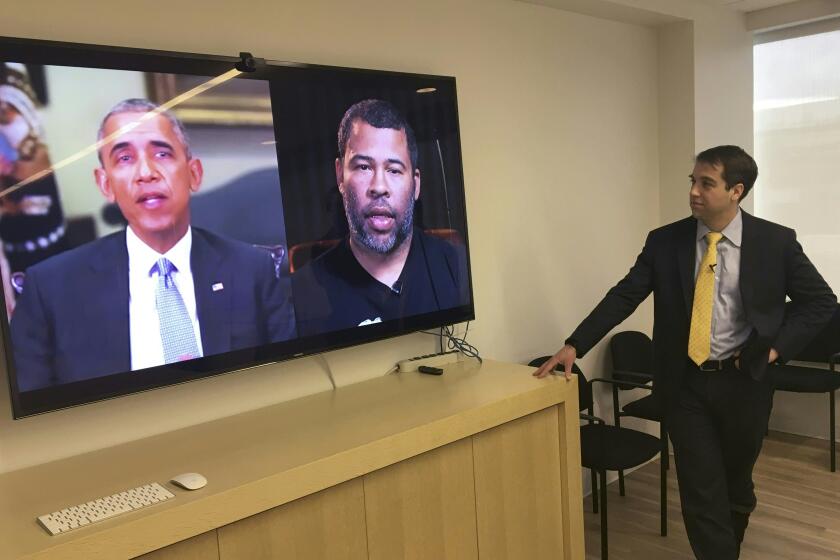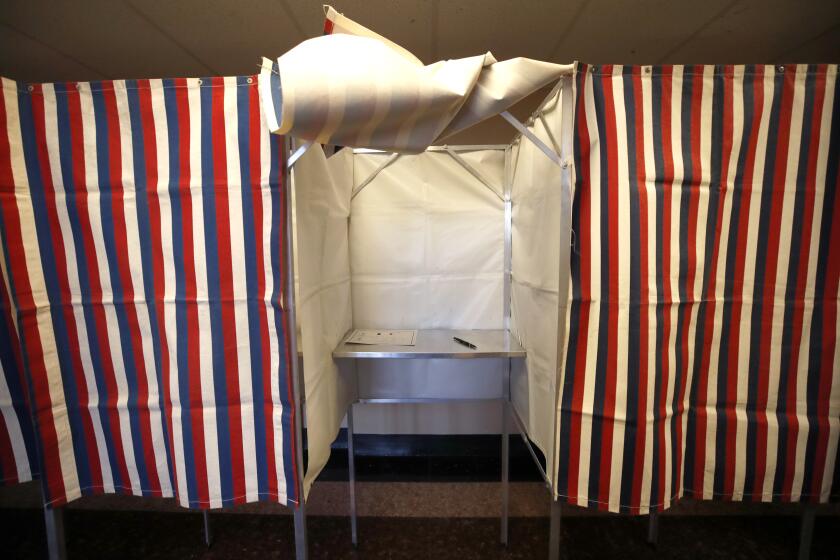Cast your mind forward. It’s Nov. 8, 2028, the day after another presidential election. This one went smoothly — no claims of rampant rigging, no significant taint of skulduggery — due in large part to the defeat of deepfakes, democracy’s newest enemy.
Is such a future possible? So far, neither government nor the tech industry has agreed on effective guardrails against deepfakes. But this FAQ (from five years in the future) shows that the events of 2024 may well force the issue — and that a solution is possible.
Why did it take so long to find an effective way to fight deepfakes?
Late in 2022, sophisticated low-cost AI software appeared that made it easy to create realistic audio, video and photographs — so-called deepfakes. As these generative AI programs rapidly improved, it grew clear that deepfake content would be a danger to democracy.
The war between Israel and Hamas is highlighting the latest advances in artificial intelligence as a way to spread fake images and disinformation.
Political deepfakes — both audio and video — soon emerged: President Biden announcing that Americans would be drafted to fight in Ukraine. A photo of Donald Trump hugging and kissing Dr. Anthony Fauci. Sen. Elizabeth Warren (D-Mass.) telling MSNBC that Republicans shouldn’t be allowed to vote in 2024. Eric Adams, the monolingual mayor of New York, speaking Spanish, Yiddish and Mandarin in AI-produced robocalls.
Very quickly, the White House, the European Union and major technology companies all launched wide-ranging AI regulation proposals that included “watermarking” AI content — inserting ID labels, a permanent bit of computer code, into the digital file of any AI-generated content to identify its artificial origin.
Lawmakers ask the CEOs of Meta and X to explain any rules they’re crafting to curb the harms of AI-generated political ads on their platforms.
But AI rule-setting proved complex, and labeling exemplified the quandaries: Would AI watermarking be legally required? How would it be enforced? As early as 2023, some cellphone cameras used AI in their image processing. What amount of AI input into content would require an identifier? Would an Instagram beauty influencer need to watermark her face-tuned selfies?
The complications were such that no system was widely adopted.
What changed?
The largest coordinated deepfake attack in history took place the day after the November 2024 election. Every U.S. social media channel was flooded with phony audio, video and still images depicting election fraud in a dozen battleground states, highly realistic content that within hours was viewed by millions. Debunking efforts by media and government were hindered by a steady flow of new deepfakes, mostly manufactured in Russia, North Korea, China and Iran. The attack generated legal and civil chaos that lasted well into the spring of 2025.
Yet none of the early authentication efforts was adopted?
Correct. The breakthrough actually came in early 2026 from a working group of digital journalists from U.S. and international news organizations. Their goal was to find a way to keep deepfakes out of news reports, so they could protect what credibility the mainstream media still retained. It was a logical assignment: Journalists are historically ruthless about punishing their peers for misbehavior, breaking out the tar and feathers for even minor departures from factual rigor.
A discussion draft of a policy proposed by Sens. Chris Coons, Marsha Blackburn and others would, if made into law, offer a legal recourse for people “cloned” by artificial intelligence software without their consent.
Journalism organizations formed the FAC Alliance — “Fact Authenticated Content” — based on a simple insight: There was already far too much AI fakery loose in the world to try to enforce a watermarking system for dis- and misinformation. And even the strictest labeling rules would simply be ignored by bad actors. But it would be possible to watermark pieces of content that weren’t deepfakes.
And so was born the voluntary FACStamp on May 1, 2026.
What does a FACStamp look like?
For consumers, FACStamped content displays a small “FAC” icon in one corner of your screen or includes an audio FAC notice. The signal can be turned off by the user, or it can be set to appear for only five or 10 seconds at the start of a media stream.
In a frightening use of deepfake technology, scammers are using AI-powered audio and video to pass themselves off as their targets’ relatives or loved ones in real time.
FACStamps are entirely voluntary. But every member of the FAC Alliance pledged that their internet, broadcast and physical reports would publish only FACStamped media in their news sections.
How does content qualify for a FACStamp?
The newest phones, tablets, cameras, recorders and desktop computers all include software that automatically inserts the FACStamp code into every piece of visual or audio content as it’s captured, before any AI modification can be applied. This proves that the image, sound or video was not generated by AI. You can also download the FAC app, which does the same for older equipment. The FACStamp is what technologists call “fragile”: The first time an image, video or audio file is falsified by AI, the stamp disappears.
Thanks to recent advances in artificial intelligence, tools that can create lifelike photos, video and audio are now cheap and readily available
But AI is often used appropriately for doing things like reducing background noise in an audio file. FacStamped content can’t be edited at all?
It certainly can. But to retain the FACStamp, your computer must be connected to the non-profit FAC Verification Center. The center’s computers detect if the editing is minor — such as cropping or even cosmetic face-tuning — and the stamp remains. Any larger manipulation, from swapping faces to faking backgrounds, and the FACStamp vanishes.
How did FACStamps spread beyond journalism?
It turned out that plenty of people could use the FACStamp. Internet retailers embraced FACStamps for videos and images of their products. Individuals soon followed, using FACStamps to sell goods online — when potential buyers are judging a used pickup truck or secondhand sofa, it’s reassuring to know that the image wasn’t spun out or scrubbed up by AI.
A mother and her 14-year-old daughter are advocating for better protections for victims after AI-generated nude images of the teen and other female classmates were circulated at a high school in New Jersey
In 2027 the stamp began to appear in social media. Any parent can artificially generate a perfectly realistic image of their happy family standing in front of the Eiffel Tower and post it or email it to envious friends. A FACStamp proves the family has actually been there.
Dating app profiles without FACStamps finally are growing rare. Videoconference apps have FAC options to ensure that everyone on the call is real. And for influencers, it’s increasingly difficult to claim “authenticity” without at least the occasional FACStamp.
Even the AI industry supports the use of FACStamps. During training runs on the internet, if an AI program absorbs excessive amounts of AI-generated rather than authentic data, it may undergo “model collapse” and become wildly inaccurate. So the FACStamp helps AI companies train their models solely on reality.
What’s next?
A bipartisan group of senators and House members plans to introduce the Right to Reality Act when the next Congress opens in January 2029. It will mandate the use of FACStamps in multiple sectors, including local government, shopping sites and investment and real estate offerings. Counterfeiting a FACStamp would become a criminal offense. Polling indicates widespread public support for the act, and the FAC Alliance has already begun a branding campaign.
The tagline: “Is that a FAC? “
Michael Rogers is an author and futurist whose most recent book is “Email From the Future: Notes From 2084.”
More to Read
A cure for the common opinion
Get thought-provoking perspectives with our weekly newsletter.
You may occasionally receive promotional content from the Los Angeles Times.







![Guitar heatmap AI image. I, _Sandra Glading_, am the copyright owner of the images/video/content that I am providing to you, Los Angeles Times Communications LLC, or I have permission from the copyright owner, _[not copyrighted - it's an AI-generated image]_, of the images/video/content to provide them to you, for publication in distribution platforms and channels affiliated with you. I grant you permission to use any and all images/video/content of __the musician heatmap___ for _Jon Healey_'s article/video/content on __the Yahoo News / McAfee partnership_. Please provide photo credit to __"courtesy of McAfee"___.](https://ca-times.brightspotcdn.com/dims4/default/f4350ab/2147483647/strip/true/crop/1600x1070+0+65/resize/320x214!/quality/75/?url=https%3A%2F%2Fcalifornia-times-brightspot.s3.amazonaws.com%2F60%2Fef%2F08cda72f447d9f64b22a287fa49c%2Fla-me-guitar-heatmap-ai-image.jpg)








